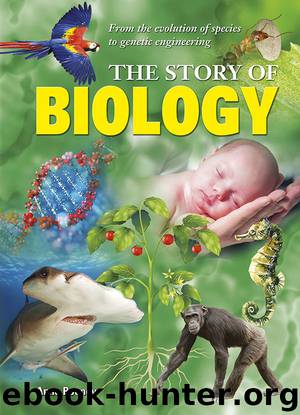The Story of Biology by Anne Rooney

Author:Anne Rooney
Language: eng
Format: epub
Publisher: Arcturus Holdings
Starting at the beginning
If nothing will come of nothing, as King Lear says, where does new life come from?
Hippocrates (460–370 BC ), considered the father of Western medicine, believed that male and female semen mix together in the female’s body after coitus and the embryo develops from this. Aristotle, around 50 years later, gave the female parent a much less interesting role. His treatise On the Generation of Animals is the first comprehensive theory of reproduction and embryonic development. Aristotle maintained that reproduction in animals relies on the male sperm to provide the essence and nature of the new organism, and the nutritive female menstrual blood to provide the material from which it is made. This was essentially what Aeschylus had said in 458 BC : that the male was the parent, and the female a ‘nurse for the young life sown within her’.
Faulty males
It might be assumed that if the female contributes nothing to the nature of the organism, all offspring would be male and the system would fall at the first hurdle, with the species dying out after one generation. But Aristotle explains that pregnancy will only result in a male which is an exact copy of the father if gestation goes perfectly according to plan. Disturbances in the pattern can lead to imperfect offspring, including females, males that look like the mother, females that look like the father, or throwbacks who look like a distant ancestor.
Aristotle’s model for generation was based on his theory that there are four ‘causes’ of existence: the final cause, formal cause, material cause, and efficient cause. The final cause is an entity’s ultimate purpose; the formal cause is its essence or existence; the material cause is what it’s made from; and the efficient cause is what brings it into existence. In looking at reproduction, the first two are quite close together: the final and formal causes of reproduction are to produce a new organism. The material cause is what produces the organism (the mother’s menstrual blood) and the efficient cause is what causes the new organism to be like it is, which is dictated by the father’s contribution. It seemed to make sense that the embryo was built from or nourished by menstrual blood, since menstruation stops during pregnancy and it was thought that the blood must go somewhere else.
Download
This site does not store any files on its server. We only index and link to content provided by other sites. Please contact the content providers to delete copyright contents if any and email us, we'll remove relevant links or contents immediately.
Sapiens: A Brief History of Humankind by Yuval Noah Harari(14315)
Sapiens by Yuval Noah Harari(5321)
Pale Blue Dot by Carl Sagan(4952)
Homo Deus: A Brief History of Tomorrow by Yuval Noah Harari(4871)
Livewired by David Eagleman(3729)
Origin Story: A Big History of Everything by David Christian(3665)
Brief Answers to the Big Questions by Stephen Hawking(3392)
Inferior by Angela Saini(3293)
Origin Story by David Christian(3170)
Signature in the Cell: DNA and the Evidence for Intelligent Design by Stephen C. Meyer(3098)
The Gene: An Intimate History by Siddhartha Mukherjee(3074)
The Evolution of Beauty by Richard O. Prum(2962)
Aliens by Jim Al-Khalili(2802)
How The Mind Works by Steven Pinker(2770)
A Short History of Nearly Everything by Bryson Bill(2659)
Sex at Dawn: The Prehistoric Origins of Modern Sexuality by Ryan Christopher(2500)
From Bacteria to Bach and Back by Daniel C. Dennett(2462)
Endless Forms Most Beautiful by Sean B. Carroll(2442)
Who We Are and How We Got Here by David Reich(2416)
